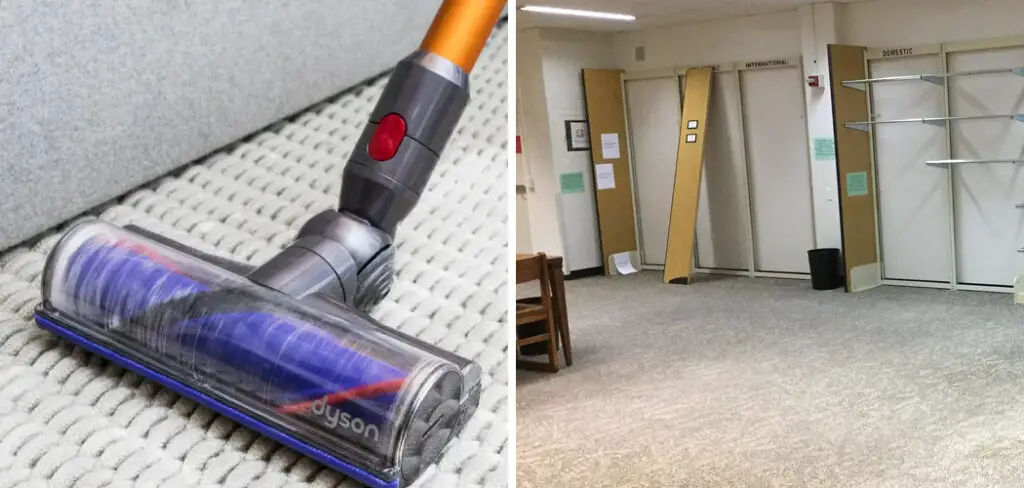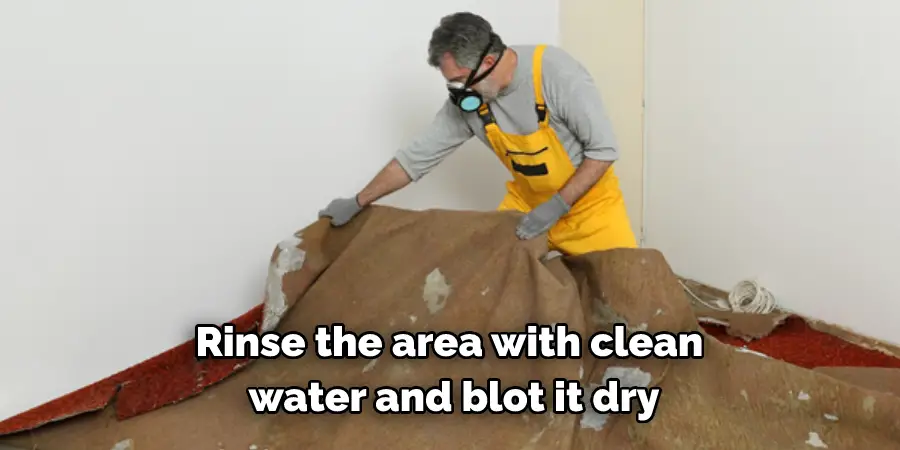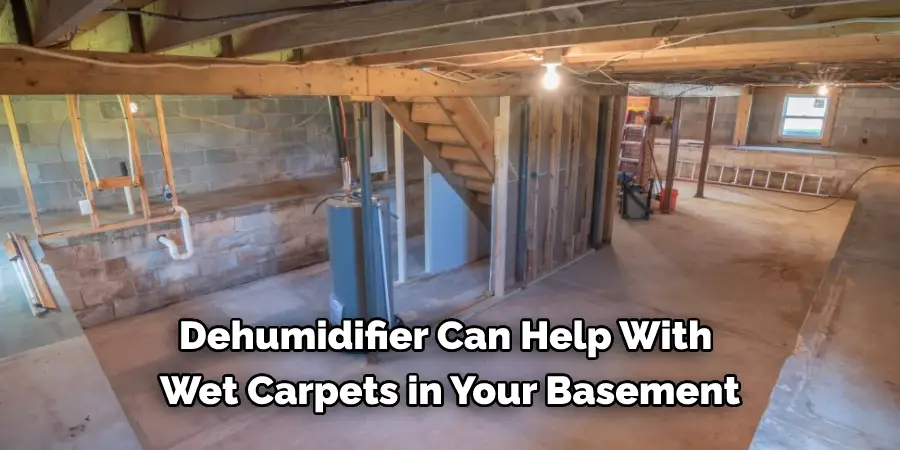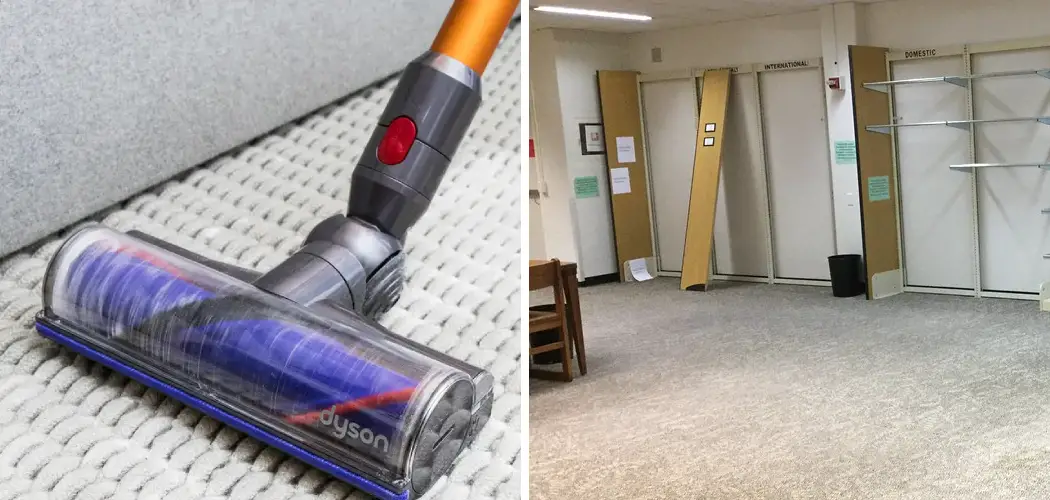Cleaning up a wet carpet in the basement can be a daunting task. However, you can get the job done quickly and easily with the right tools and techniques. The first step is to remove all of the furniture from the area. Once the furniture is out of the way, you can begin to assess the damage. Before proceeding, you must treat any mold or mildew with a mold and mildew remover. Next, use a wet/dry vac to remove as much water from the carpet as possible.
Once most of the water has been removed, you can begin cleaning the carpet with a mild detergent. Be sure to rinse the area well after cleaning to remove any residual detergent. Finally, use fans or a dehumidifier to help dry the area completely. In this blog post, you will learn in detail how to clean wet carpet in basement.

What Are Some Common Causes of Wet Carpet in the Basement?
There are many reasons why your basement carpet may be wet. Some common causes include:
- A leaking or burst pipe: If you have a pipe that is leaking or has burst, it can cause water to seep into your carpet and make it wet.
- Heavy rains: If there has been a lot of rain, the ground around your home can become saturated, and water can seep into your basement through cracks in the foundation or walls.
- Excess humidity: If the air in your basement is very humid, it can cause your carpet to become damp. You may need to use a dehumidifier to reduce the humidity levels in your basement.
- A spill or accident: If you have a spill or accident and your carpet gets wet, it’s important to act quickly to clean it up and dry it out. Otherwise, you risk the growth of mold and mildew, which can damage your carpet and create an unhealthy environment.
Whatever the cause, cleaning up wet carpeting as quickly as possible is important to prevent mold and mildew from growing.
Step-by-Step Processes for Cleaning Wet Carpet in Basement
Step 1: Remove as Much Water as Possible:
The first step is to remove as much water from the carpet as possible. This can be done using a wet/dry vacuum or blotting the area with towels.
Step 2: Treat the Area With a Carpet Cleaner:
Once you have removed as much water as possible, you must treat the area with a carpet cleaner. There are many different types of cleaners available, so be sure to read the labels carefully and choose one that is designed for use on wet carpets.

Step 3: Rinse the Area With Clean Water:
After treating the area with a carpet cleaner, you must rinse it with clean water. This will help to remove any residual cleaner from the carpet and will also help to restore the pH balance of the carpet.
Step 4: Allow the Area to Dry Completely:
Once you have rinsed the area with clean water, you will need to allow it to dry completely. This may take several hours or even days, depending on the size of the affected area. Once the area is dry, you can vacuum it to remove any remaining water and restore the carpet to its original condition.
Step 5: Apply a Dehumidifier:
If the area is still damp, you must apply a dehumidifier. This will help to remove any remaining moisture from the carpet. Place the dehumidifier in the area and turn it on. Make sure to empty the water reservoir regularly.
Step 6: Vacuum the Carpet:
Once the carpet is dry, you can vacuum it to remove any dirt or debris that may have been left behind. Be sure to vacuum the entire area, including the edges and corners.
Step 7: Apply a Stain Remover:
You will need to apply a stain remover if there are any stains on the carpet. Many different products can be used, but we recommend using a mild detergent or carpet cleaner. Apply the solution to the stain and scrub it with a brush or cloth. Rinse the area with clean water and blot it dry.

Step 8: Vacuum the Carpet:
Once the carpet is dry, you will need to vacuum it. This will help remove any dirt or debris that may have been left behind. Be sure to vacuum the entire area, including the edges and corners.
Step 9: Inspect the Carpet:
Once you have vacuumed the carpet, you will need to inspect it for any damage. If there are any tears or holes, you will need to repair them before using the carpet again. If the carpet is badly damaged, you may need to replace it.
After you have inspected the carpet, you will need to dry it. You can do this by using fans or a dehumidifier. If the weather is warm and sunny, you can also open the windows to help air out the area and speed up the drying process.
Step 10: Enjoy the Carpet:
After the carpet is dry and repaired, you can enjoy it once again. Be sure to vacuum regularly and spot-clean as needed to keep the carpet looking its best.
You Can Check It Out to Clean Dusty Concrete Basement Floor

Safety Tips for How to Clean Wet Carpet in Basement
- If you can, try to remove as much water from the carpet as possible before starting the cleaning process.
- Vacuum the carpet using a wet/dry vacuum.
- Use a mild detergent and warm water to spot-clean any areas of the carpet that are particularly soiled or stained. If you have a steam cleaner, you can use it to clean the entire carpet.
- Once you’ve finished cleaning, make sure to dry the carpet completely by ventilation and/or using a floor fan.
- Treat the affected areas with an antimicrobial solution if mold or mildew is present. Once the carpet is completely dry, vacuum it again to restore the pile and fluffiness.
- If the carpet is still wet in spots, you can place absorbent materials (such as towels or newspapers) on top of the wet areas and weigh them down with something heavy.
- Check the carpet periodically to make sure it is completely dry.
- Call a professional carpet cleaner if the carpet is not drying properly or if mold or mildew is present.
How Can You Prevent Your Carpet From Getting Wet in the First Place?
It’s always best to try and prevent your carpet from getting wet in the first place. Here are some tips on how to do that:
- Make sure all of your windows and doors are properly sealed and caulked.
- Check your gutters and downspouts to ensure they’re clean and functioning properly.
- If you have a sump pump, ensure it’s in good working order.
- Keep an eye on the weather forecast and be prepared to take action if there’s a chance of flooding.
Will a Dehumidifier Help With Wet Carpet?
If you’ve ever had a wet carpet, you know how miserable it can be. It is smelly and uncomfortable and can also be a breeding ground for mold and mildew. If you have a wet carpet in your basement, you may wonder if a dehumidifier will help.
The short answer is yes, a dehumidifier can help with wet carpets in your basement. By reducing the amount of moisture in the air, a dehumidifier will help to dry out your carpet and prevent mold and mildew from growing. If you have a lot of wet carpets in your basement, you may need more than one dehumidifier to get the job done.
You should also consider running a fan in the room to help circulate the air and speed up the drying process. Once your carpet is dry, be sure to vacuum it thoroughly to remove any dirt or debris that the water may have deposited. Then, shampoo the carpet to remove any lingering odors. With little time and effort, you can get your wet carpet dry and smelling fresh again. And with a dehumidifier on hand, you can rest assured that your basement will stay dry and mold-free.
You Can Check It Out to Clean Concrete Basement Floor After a Flood

Conclusion
Basements can be tricky to keep clean and dry, especially if you have wet carpet. But with a little know-how and the right tools, you can easily clean your wet carpet and keep your basement looking great. Cleaning up the wet carpet in your basement may seem daunting, but it doesn’t have to be. With these four easy steps, you’ll clean and dry your basement carpets in no time.
And if you ever find yourself with another flooded basement, you’ll know exactly what to do.
With a little bit of effort, you can easily clean wet carpet in your basement and keep your home looking its best. We hope this article has been beneficial in learning how to clean wet carpet in basement.

